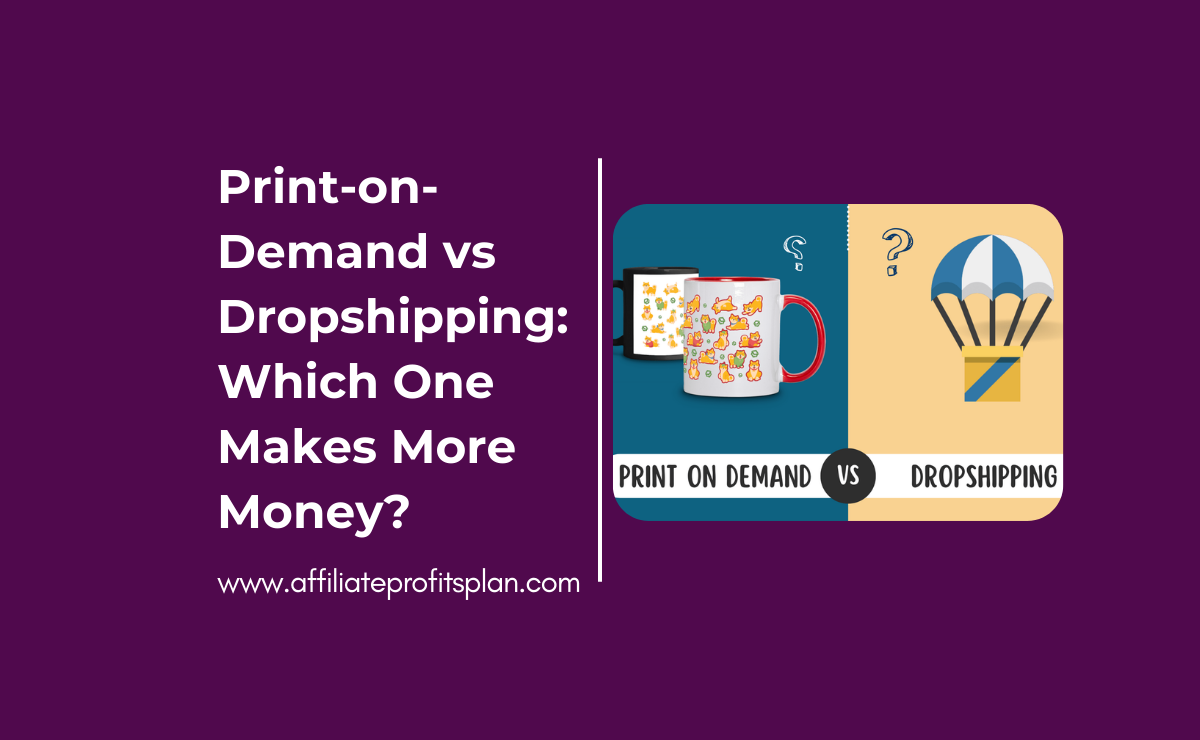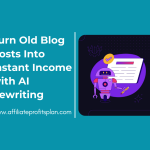Welcome to my article “Print-on-Demand vs Dropshipping: Which One Makes More Money?” So, you want to start an online business, but you’re stuck between Print-on-Demand (POD) and Dropshipping—two of the most popular low-cost eCommerce models. Both promise passive income, both let you sell products without keeping inventory, and both sound like the perfect way to make money while sipping coffee in your pajamas. But here’s the million-dollar question: Which one actually makes more money?
The truth is, both business models have their strengths and weaknesses. POD is great if you love designing unique products and want to build a brand, but the profit margins can be slim. Dropshipping, on the other hand, lets you sell a wide variety of products with potentially higher margins, but you’ll be competing with thousands of other sellers selling the exact same thing. It’s kind of like choosing between making your own fancy latte at home or buying a Starbucks frappuccino—both get the job done, but the experience (and profit) is different.
In this article, we’ll break down Print-on-Demand vs. Dropshipping from a profitability standpoint. We’ll compare startup costs, profit margins, scalability, and which model is better for long-term success. By the end, you’ll know exactly which one fits your goals—and maybe even get inspired to start your own online store today. Let’s dive in!
Access Our Proven Tested Formula for $50-$100 Daily Income – Watch This FREE Video >>

What is Print-on-Demand (POD)?
Imagine selling t-shirts, mugs, or phone cases with your own custom designs—all without ever touching a single product. That’s Print-on-Demand (POD) in a nutshell. Instead of stocking inventory, you upload your designs to a platform (like Printify, Printful, or Teespring), and when someone places an order, the product is printed and shipped directly to the customer. No bulk orders, no warehouse costs, and no dealing with leftover stock that nobody wants (looking at you, “World’s Best Cat Dad” mug that never sold).
The beauty of POD is that it lets you create a unique brand without upfront investment in inventory. You focus on designing and marketing, while a third-party supplier handles the production and shipping. This makes it perfect for artists, designers, or anyone with a knack for catchy slogans (because, let’s be honest, people love a funny t-shirt).
However, there’s a catch: POD profit margins tend to be lower than other eCommerce models because each item is made to order. A custom-printed hoodie might cost you $20 to produce, and if you sell it for $35, you only pocket $15—before ad costs and platform fees. So, while POD is great for creativity and branding, you’ll need strong marketing strategies to make serious money.
Still, if the idea of running an online business without handling inventory sounds appealing, POD could be your perfect side hustle—or even a full-time gig. Now, let’s see how it stacks up against dropshipping!
What is Dropshipping?
Dropshipping is like running an online store without the headache of inventory. Instead of stocking up on products, you list items for sale on your website or marketplace (think Shopify, WooCommerce, or eBay). When a customer places an order, you buy the product from a supplier—usually based in China (AliExpress, CJdropshipping) or local warehouses—and they ship it directly to the customer. No storing, no packing, no trips to the post office. It’s as hands-off as eCommerce gets!
So, what’s the catch? While dropshipping saves you money upfront (because you only buy products after you’ve sold them), it comes with thin profit margins and long shipping times—especially if your supplier is halfway across the world. Customers aren’t thrilled about waiting 3-4 weeks for a product, and if you’re not careful about product quality, bad reviews can tank your business faster than you can say “refund request.”
However, if you play it smart, dropshipping can be highly profitable. Many successful dropshippers focus on winning products—unique items that solve a problem or trend well on social media. Plus, with the right marketing (Facebook Ads, TikTok trends, influencer shoutouts), you can scale quickly and turn a simple store into a six-figure business.
In short, dropshipping is a low-risk, high-reward game—but only if you’re willing to master product research, marketing, and customer service. Now, let’s see how it stacks up against Print-on-Demand in the battle of online business models!
Profitability Breakdown: Which One Makes More Money?
Alright, let’s talk about what really matters—cold, hard cash. Both Print-on-Demand (POD) and Dropshipping offer a low-cost way to start an online business, but when it comes to profitability, things get a little interesting.
Profit Margins: Who Wins?
- Print-on-Demand (POD): On average, profit margins in POD range from 20% to 50%, depending on how much you price your designs. A custom T-shirt might cost you $12 to produce, and if you sell it for $25, you’re making a profit of about $13 before marketing costs.
- Dropshipping: Profit margins in dropshipping can vary widely—anywhere from 10% to 60%. Many successful dropshippers aim for at least a 30-40% margin. For example, if you source a product for $10 and sell it for $30, you walk away with $20—not bad, right?
Winner? Dropshipping usually has higher potential profit per item, especially if you find a trending product with a strong markup. However, with POD, you have less risk of product saturation since designs are unique to your brand.
Marketing Costs: Where Does the Money Go?
Both models rely heavily on marketing, especially Facebook Ads, Google Ads, and TikTok promotions. However, there’s a key difference:
- POD relies on unique designs. If your artwork doesn’t resonate with an audience, you could be throwing money at ads with little return.
- Dropshipping is more about finding viral products. The challenge? As soon as a product goes viral, competitors flood the market, driving ad costs up.
Winner? POD wins long-term because you can build a brand around your designs. Dropshipping can be hit-or-miss, depending on how fast you can scale before competitors catch on.
Access Our Proven Tested Formula for $50-$100 Daily Income – Watch This FREE Video >>
Scaling: Which One Grows Faster?
- Dropshipping has massive scaling potential. If you find a hot product and aggressively run ads, you can hit $10,000+ per month within weeks. The downside? If you don’t keep finding new winning products, your store can die just as fast.
- POD is slower to scale but has better long-term stability. A successful POD brand can grow into a loyal fanbase (think: a niche T-shirt brand that people love). Plus, you can expand your product line without changing suppliers.
Winner? Dropshipping for fast profits, POD for long-term branding and passive income.
Final Verdict: Which One Makes More Money?
If you want quick cash, dropshipping is the way to go—higher margins, faster scaling, but more competition. If you prefer a brand-focused business with more creative control, Print-on-Demand is a sustainable, long-term income stream.
Bottom line? The best business is the one you actually stick with.
Choosing the Right Business Model for You
So, Print-on-Demand (POD) and Dropshipping both have their pros and cons—but which one is actually right for you? Well, that depends on your personality, budget, and patience level. Let’s break it down.
1. Are You a Creative Genius or a Product Hunter?
- If you love design, branding, and creating unique products, then POD is your game. You get to build a business that reflects your creativity, whether that’s funny T-shirts, aesthetic phone cases, or niche-themed hoodies.
- If you’re more about finding trending products and riding the hype wave, then dropshipping is for you. The focus here is spotting viral products, testing them with ads, and scaling winners fast before competitors flood the market.
Pick POD if: You enjoy the creative process and want to build a long-term brand.
Pick Dropshipping if: You love testing products, analyzing market trends, and scaling fast.
2. How Much Patience Do You Have?
- POD is a slow burn. It takes time to build an audience and find designs that people love. But once you do, you can create a loyal customer base that buys from you over and over again.
- Dropshipping is a rollercoaster. You might find a winning product in one week or one year. The upside? If you hit the jackpot, you can make $100K+ in a few months. The downside? The market gets saturated fast, and you need to keep finding new products.
Pick POD if: You prefer slow but steady growth and brand-building.
Pick Dropshipping if: You’re okay with trial-and-error and fast market shifts.
3. How Much Money Can You Invest?
- POD has lower upfront costs—you only pay for a product after someone buys it. But designing products (or hiring designers) and running ads can still add up.
- Dropshipping requires more ad spend. Since you’re competing in a fast-moving market, you need a decent ad budget ($500–$1,000 minimum) to test products properly.
Pick POD if: You want to start with less upfront investment and grow organically.
Pick Dropshipping if: You have some money to spend on ads and can afford to test multiple products.
4. Do You Want to Build a Brand or Just Make Quick Cash?
- POD is better for long-term brand building. If you create a solid niche brand, you can eventually sell your store for a huge profit.
- Dropshipping is great for fast profits, but stores are harder to sell because the business model relies on finding new products constantly.
Pick POD if: You want a business that lasts and builds brand loyalty.
Pick Dropshipping if: You’re more interested in short-term gains and quick flips.
Final Thought: Which One Should You Choose?
If you’re creative, patient, and want to build a long-term brand, go for Print-on-Demand. If you’re more of a data-driven, risk-taking entrepreneur who wants to test products fast, try Dropshipping.
Still can’t decide? Why not test both? Many entrepreneurs combine POD and Dropshipping to create a hybrid store—best of both worlds!
Conclusion: Which One Wins?
So, after breaking it all down—Print-on-Demand vs. Dropshipping—who takes the crown? Well, that depends on YOU (yeah, we’re putting the pressure back on you).
If you’re someone who loves creativity, brand-building, and long-term business growth, POD is your best bet. You get to design unique products, build a loyal fanbase, and eventually turn your store into a recognized brand. But keep in mind—it’s a slow burn, and success doesn’t happen overnight.
Access Our Proven Tested Formula for $50-$100 Daily Income – Watch This FREE Video >>
On the other hand, if you’re more about testing trends, scaling fast, and maximizing short-term profits, dropshipping might be your playground. It offers higher earning potential faster, but it’s also riskier and more competitive. One winning product can change your life, but one bad ad campaign can burn through your budget.
At the end of the day, both models can make money—it’s all about how you play the game. Want long-term stability? POD is for you. Want fast cash and don’t mind taking risks? Dropshipping might be the move.
Or, if you really want to maximize your chances, why not try a hybrid approach? Some sellers combine POD and dropshipping in the same store, giving them the best of both worlds.
Whatever you choose, the key is taking action. The biggest mistake you can make? Overthinking and never starting.
Thanks a lot for reading my article on “Print-on-Demand vs Dropshipping: Which One Makes More Money?” till the end. Hope you’ve helped. See you with another article.










